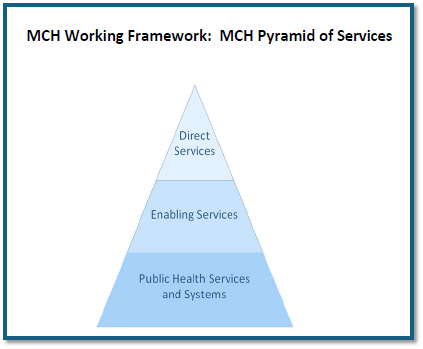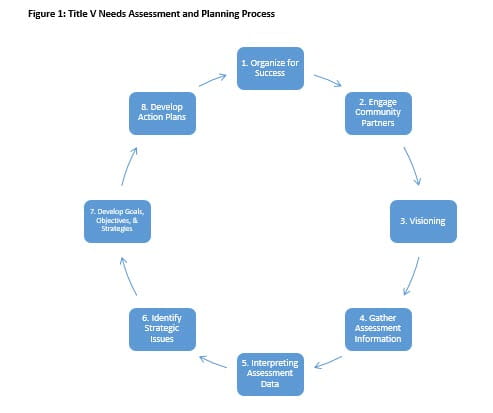
LMCH Program Overview: Local Maternal Child Health (LMCH) funding is made available to local health departments to support the health of women, children, and families in communities across Michigan. Funding is made available through the Title V Maternal and Child Health (MCH) Services Block Grant to address national and state priority areas and/or a local MCH priority need identified through a needs assessment process. Local health departments complete an annual LMCH plan, which describes the jurisdiction's priority maternal and child health needs; the action steps that will be used to address these needs; and the service categories from the MCH pyramid of services. Target populations are women of childbearing age, mothers, infants, children ages 1-21 and their families, and children with special health care needs. Michigan's MCH focus areas for 2021-2025 include low-risk cesarean delivery, infant safe sleep, breastfeeding, bullying prevention, oral health for women and children, transition to adult health care for children with special health care needs, childhood lead poisoning prevention, immunizations, medical care, and treatment for children with special health care needs, intended pregnancy, and behavioral/mental health services. The focus of local programming is to provide the target population with increased access to and provision of gap-filling services; enabling services such as case management and epidemiologic support; public health services and systems; and interventions to address community-specific MCH needs.
Legal Basis: PA 368 of 1978, Part 23 basic health services; Federal Title V Sec 501 [42 U.S.C. 701]
Program Effectiveness: Local health departments are required to provide an annual year-end report which includes a summary of the fiscal year's activities, a brief description of any challenges and successes, the number of individuals served and the amount of MCH funds expended. MCH funds provide critical gap-filling services at the local level; increase availability of existing services; expand the number of individuals receiving services; and support public health infrastructure costs to deliver essential public health services.
Local MCH Vision and GoalsTitle V of the Social Security Act of 1935 authorized funding for Maternal and Child Health (MCH) Services. The Title V MCH Block Grant is the nation's oldest federal-state partnership focused on improving the health of mothers, infants, and children, including children with special health care needs. Since its original authorization in 1935, Title V of the Social Security Act has been amended to reflect a continuing national focus on maternal and child health. In 2015, Title V was transformed to reflect updated performance measures, utilization of data-driven processes, and family engagement. In 2024 the Title V guidance introduced a revised performance measure framework and builds on/refines the reporting structure and vision outlined in previous editions. Each State's health agency is responsible for the administration (or supervision of the administration) of programs carried out with allotments made to the State under Title V. In Michigan, the Title V MCH Block Grant supports a wide range of critical MCH programs and services across the state. The overarching goal is to improve the health and well-being of the state's mothers, infants, children, and adolescents-including children with special health care needs. Title V funding is allocated to each of Michigan's 45 local health departments (LHDs) through the Local Maternal Child Health (LMCH) program. Approximately one-third of the state's Title V funding supports the MCH work of these 45 LHDs across the state. LMCH funds are available to support one or more Title V national performance measures or state performance measures plus locally identified needs. Each LHD completes a work plan for every performance measure selected. The LMCH grants play an important role in building and sustaining LHD public health systems and supporting the delivery of needed programs and services.
Title V Pyramid of Services*
The conceptual framework for services supported by the Title V Maternal and Child Health Services Block Grant is envisioned as a pyramid with three tiers of services: direct, enabling, and public health services and systems. The three tiers align with the 10 MCH Essential Services. The 10 Essential Public Health Services (EPHS) describe the public health activities that all communities should undertake. The EPHS framework was updated in 2020. For more information: CDC - 10 Essential Public Health Services - Public Health Infrastructure Center Direct Services are preventive, primary, or specialty clinical services to individuals for which funds reimburse or provide payment to providers for services. Enabling Services are non-clinical services (i.e., not included as direct or public health services) that enable individuals to access health care and improve health outcomes. Public Health Services and Systems are activities and infrastructure to carry out the core public health functions of assessment, assurance, and policy development, and the 10 essential public health services. 1 10 Essential Public Health Services Futures Initiative Task Force. 10 Essential Public Health Services. September 9, 2020. https://phnci.org/uploads/resource-files/EPHS-English.pdf *Reference: U.S. Department of Health and Human Services, Health Resources and Services Administration, Maternal and Child Health Bureau, Title V Maternal and Child Health Services Block Grant to States Program. Guidance and forms for the Title V application/annual Report. Tenth Edition. OMB NO 0915-0172, Expires 12/31/2026; p.82. Title V Block Grant Guidance and Reporting Forms_OPAE_4.13.23 (hrsa.gov)
Title V State PrioritiesThe federal Health Resources and Services Administration (HRSA) established 20 National Performance Measures (NPMs) across five population health domains for the Title V MCH Services Block Grant program. States can select the best combination of NPMs, including universal measures, and state-identified State Performance Measures (SPMs) to address each priority need based on the findings of the five-year needs assessment. States must select a minimum of one NPM in each population domain. Michigan's current performance measures are identified in the table below.
| NPM | Priority Area | National Performance Measure |
| 2 | Low-risk cesarean delivery | Percent of cesarean deliveries among low-risk first births |
| 4 | Breastfeeding | A) Percent of infants who are ever breastfed and B) Percent of infants breastfed exclusively through 6 months |
| 5 | Safe Sleep | A) Percent of infants placed to sleep on their backs, B) Percent of infants placed to sleep on a separate approved sleep surface, and C) Percent of infants placed to sleep without soft objects or loose bedding |
| 9 | Bullying | Percent of adolescents, ages 12 through 17, who are bullied or who bully others |
| 12 | Transition | Percent of adolescents with special health care needs, ages 12 through 17, who received services necessary to make transitions to adult health care |
| 13 | Preventive dental visit | A) Percent of women who had a dental visit during pregnancy and B) Percent of children, ages 1 through 17, who had a preventive dental visit in the past year |
| SPM | Priority Area | State Performance Measure (SPM) |
| 1 | Childhood lead poisoning prevention | Percent of children less than 72 months of age who receive a venous confirmation testing within 30 days of an initial positive capillary test |
| 2 | Immunizations (Children) | Percent of children 19 to 36 months of age who have received a completed series of recommended vaccines (4:3:1:3:3:1:4 series) |
| 3 | Immunizations (Adolescents) | Percent of adolescents 13 to 18 years of age who have received a completed series Human Papilloma Virus (HPV) vaccine |
| 4 | Provision of medical services & treatment for CSHCN | Percent of CYSHCN enrolled in CSHCS that receive timely medical care and treatment without difficulty |
| 5 | Intended pregnancy | Percent of women who had a live birth and reported that their pregnancy was intended |
| 6 | Behavioral/mental health | Support access to developmental, behavioral, and mental health services through Title V activities and funding |
The needs assessment process was designed to align with both the Title V MCH Needs Assessment model and the National Association of City and County Health Officials' (NACCHO) Mobilizing for Action through Planning and Partnerships (MAPP) model. Technical assistance was provided through a series of webinars at each step of the process (see Webinar section for links). A copy of the MCH Needs Assessment template is available here and may be downloaded to assist with your MCH Needs Assessment.
Thirty-six LHDs and the Northern Michigan Public Health Alliance completed the LMCH Needs Assessment. A summary report of the LMCH needs assessment is available here.
Local MCH Program RequirementsLMCH Annual Plan Each year local health departments (LHDs) complete a Local Maternal Child Health (LMCH) Plan. The LMCH Plan reflects how LHDs will utilize LMCH funding. The LMCH Plan document describes the local health department's jurisdiction and MCH population; priority MCH issues the LHD will address; performance measure(s) the LHDs will address and the related goals and objectives; data relevant to objective/performance measure; evidence-based/informed/promising practice strategies; and activities the LHD will undertake to reach their objective(s) using LMCH funds. The LMCH Plan also describes the projected number of individuals the health department will serve along with the projected costs of providing those services. Local health departments are encouraged to select only one to two performance measures and delve deeper into the strategies to "move the needle" on MCH outcomes. A copy of the current LMCH Annual Plan template is available here and can be downloaded. LMCH Year-End Report At the end of the fiscal year, LHDs report on activities and progress toward achieving their objectives, the number of individuals served, and the total amount of funding expended. The health department is also asked to describe any challenges and successes they experienced in delivering services. The year-end report should only include activities and expenditures for which LMCH funds were used. MDHHS provides each LHD with a customized year-end report template based on their LMCH Annual Plan.
Data and Surveillance LinksThe following websites are resources that summarize and visualize data that may be helpful when completing the LMCH Annual Plan and Year-End Report.
The following websites are data resources that focus on maternal and child health.
Title V MCH Block Grant Links
Other
PowerPoint slides are available here
PowerPoint slides are available here and sample data file is available here
PowerPoint slides are available here
PowerPoint slides are available here
PowerPoint slides are available here
PowerPoint slides are available here
PowerPoint slides are available here
LMCH Needs Assessment Webinars
In 2017, the Michigan Department of Health and Human Services (MDHHS) and the Michigan Public Health Institute (MPHI) partnered to facilitate an LMCH needs assessment. The needs assessment process is designed to align with both the Title V MCH Needs Assessment model and the National Association of City and County Health Officials' (NACCHO) Mobilizing for Action through Planning and Partnerships (MAPP) model. An overview of the steps in the process is shown in Figure 1.

A series of eight webinars was created to provide support to LHDs as they completed the MCH needs assessment.
PowerPoint slides are available here
PowerPoint slides are available here
PowerPoint slides are available here
PowerPoint slides are available here
PowerPoint slides are available here
PowerPoint slides are available here
PowerPoint slides are available here
PowerPoint slides are available here